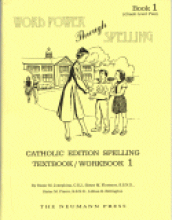No name
Wooden Pattern Blocks
These beautiful wooden blocks are about 1/8th of an inch thick and come in six different shapes (each shape is a different color).They can be fitted together to make beautiful patterns and designs. We've been using them for many years and they've been a hit with every one of my children. They're fun and beautiful and promote fine-motor skills, eye-hand coordination (intricate patterns can be too frustrating to really young children) and visualization and thinking skills. One way I use them with my kindergarteners is this: the child and I will each start a pattern or design and then switch so that the other one has to finish it. The wooden set has such a nice feel to it - playing with it is so relaxing and peaceful for young children (especially while you're trying to work on academics with older siblings.
Available in various materials, sizes and quantities - we prefer the wooden set.
Wooden Rosary Holder Kit from Illuminated Ink
Word Power Through Spelling: Catholic Edition
First Lesson Word List: a, big, dog, is, my Final Lesson Word List: way, glad, happy, how, ten, stand, very, name, walked, train Weekly lessons introduce a new word list (the number of words in the list increase as the book progresses) and gives practice writing and recognizing the words in the context of sentences and to describe illustrations. Some handwriting practice is included (including a page with directions for printing, and later in the text one for writing cursive letters). The text works a bit on the meaning of words but doesn't get into phonetic rules. A special format for keeping track of and practicing problem words allows the student to additional review throughout the text for problem areas. There are some instructions to the teacher at the beginning of the book which outline "how to study a missed word" and how the lesson plan is supposed to work. Directions to the students are intermixed with the text, but I found it difficult in a few places to determine what was to be done.
The text reminds me of the Rod and Staff workbooks, but with some Catholic content.
Word to Caesar
World War II for Kids
The tone of the entire book is pro-American and patriotic. I particularly enjoyed the author's nostalgic reflections on some of the more wholesome entertainers of the day - like Bud Abbott and Lou Costello. First-hand accounts of various parts of life at that time are scattered throughout the book and cover an impressive array of nationalities. The 21 activities advertised in the title are very creative, but not overwhelming. Some of my favorites include: Decoding a Message, Rationing Game, and Make a Ration Kit (this is very detailed and fascinating).
This book would be particularly interesting for a family interested in delving deeper into World War II than the history textbooks do. It gives a great, but easy-to-use overview of the whole war chronologically (I learned a lot from reading it myself!). Combined with a dozen or so living history books, this could make a fun summer project or unit study for the entire family.
The author has done a fine balancing job in keeping the material appropriate for children without watering it down. However, there are a few areas that might be inappropriate for younger children - particularly the segment on the Holocaust.
Woven Cross Kit from Illuminated Ink
This inexpensive Woven Cross Kit provides materials for three beautiful woven crosses. Each kit comes with thin strips of vellum paper 3 ½” x 3” (The primary kit colors are green, purple, pink, and red), gold or silver "nail" studs, colored metal hearts, and step-by-step illustrated instructions. The quality and beauty of the materials is impressive.
Plus, the same technique that children will learn from this kit can be used to weave fresh palm fronts from Palm Sunday into crosses as well.
The kit is also available in a "class pack" with materials to make 30 crosses in assorted colors.
WriteGuide.com Individualized Writing Course
We've all heard the whining and complaining that can come with teaching composition. Many children just refuse to make the effort to write, and when they finally do finish an assignment their parents agonize over how to grade the composition. Having heard the writing complaints for years, I am excited to report that there is now a solution in WriteGuide.com.
Last month two of our children participated in an online tutorial through WriteGuide.com. Wait–before you stop reading because "those things are too pricey for our family," let me assure you, this tutorial is very affordable. Our children had a great time working on several different compositions that were a part of their tutorial and anxiously waited each day for an e-mail response from their tutor. Writing has never been so easy in our home.
WriteGuide.com provides individualized writing courses for as short as 1 month or as long as 12 months. The parent determines the goals of the course and, along with the tutor (all teachers hold masters degrees and have extensive teaching experience) the course content is decided. The students may either have "from scratch" writing assignments, as my children did, or follow a curriculum that the family is already using. The tutor contacts the parent through e-mail to establish the relationship and then the course begins. Each day the student submits his assignment and receives a reply that same day from his teacher. This is not an abstract relationship or one based on forms; the student chats with his teacher through e-mail and receives a personal, friendly reply that motivates the child while at the same time instructing him on style, grammar, mechanics, etc. as they directly relate to his writing assignment. You can see samples of e-mail exchanges between students and teachers at http://writeguide.com/samples.htm
Our online tutorial was a month long and went from the 2nd of one month until the 2nd in the next calendar month. Rather then have one child do the tutorial for the entire month, our 15-year-old son worked with the teacher for three weeks and our 12-year-old daughter worked with her for the remaining 5 or 6 days. The variety of assignments that WriteGuide will allow is quite varied. While working with the teacher, our son wrote a six-page research report on religious symbolism along with a complete bibliography. (What a relief not to have to teach that myself!) He also wrote the beginning of a fantasy novel. Our daughter, who normally hates writing, cheerfully wrote an essay about the Hittites and is begging to do another writing tutorial. I am amazed at how much her writing improved in just one week's time. The teacher was flexible and enthusiastic throughout the course and we were especially happy to learn that she was Catholic. WriteGuide.com employs several Catholic teachers and matches them up with Catholic families upon request.
I'm very impressed with the quality of WriteGuide.com and highly recommend it for both home school families and public school students. You'll be surprised at how much your child will learn in just one month.
Writing Strands
The Writing Strands program focuses on the structure of writing by teaching the student to organize his thoughts before writing. Many of the ideas the author uses are found in other English programs, such as Voyages in English, but in WS they are presented in a more systematic fashion with each lesson building on preceding lessons. The lessons are written for the child to read and do independently, with the parent checking work occasionally. WS is very straightforward and directs the child to write about specific topics. I liked this approach, but after working through half of WS3 my son was less then enthusiastic about continuing. Some of the topics he couldn't relate to and others were boring. While his writing was organized, I didn't see any improvement in sentence complexity. I continued to search for a writing program that would work for our family and discovered the Institute for Excellence in Writing.








